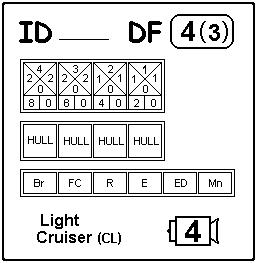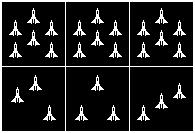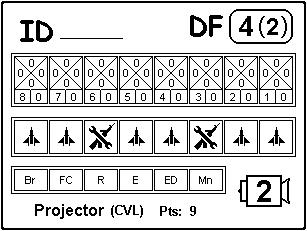

 |
|
Beka Eslar allowed her gaze to wander about the cramped and cluttered confines of her duty station. Observation outpost 234, one of the many unsung guardians for the Colm Star System, was without doubt the most boring assignment she'd ever drawn, and it would be a minor miracle if she finished her tour of duty here with her sanity intact.
"I'm gonna go nuts" Beka remarked aloud. Her voice echoed dully off the bulkheads. "See, I'm already half way there. I'm talking to myself".
Suddenly, a series of warning lights lit up her sensor boards. Beka felt chilled as she applied herself to her scanner controls and tried to refine the data that was pouring into her computers from the system's sensor net. "Status report!" The voice of the outpost commander boomed over the intercom.
"Commander, we have multiple contacts with an estimated 100 plus warships. They are a mix of capital ships, cruisers and light escorts - I think there are also several troop transports following the warships". Beka spoke as calmly as she could manage into her bridge pickup. It looked like the war had finally come to the Colm system after all.
I have always been interested in science fiction. Whether it was in books, TV or movies, scifi has been one of my favourite literary genres since I was very young. Much later, when I discovered wargaming, it was only natural for me to combine these two favourite hobbies. Through the years I've played many scifi games and found several favourites that have stood the test of time. However, none really seemed designed to recreate those great fleet battles, those most dramatic of moments when entire empires stood or fell.
And so, to fill that void, these rules were born. Instead of being just the captain of a few ships, you take the place of an admiral, commanding entire fleets. Using simple, fast moving game mechanics, these rules attempt to portray the important aspects of huge fleet engagements without becoming too bogged down in time consuming detail. They're for those players willing to sacrifice some complexity to achieve a fast moving, playable, and most importantly, FUN game.
All the basic rules needed to play the game can be found here on this webpage, along with a small selection of the optional
rules.
Give them a try - it may look like a lot of rules, but they're pretty simple in action.

SHIP CONCEPTS
Mass
As with modern wet navies, ships tend to be further classified into categories of mass. A Sky Full Of Ships follows this example with mass categories of its own. The below table shows the mass (number of hull boxes) of the different classes of ships.
| Frigate: 1 | Heavy Cruiser: 5 or 6 | Dreadnaught: 13 to 18 |
| Destroyer: 2 | Battle Cruiser: 7, 8 or 9 | Superdreadnaught: 19 to 24 |
| Light Cruiser: 3 or 4 | Battleship: 10, 11, or 12 | Titan: 25 or more |
Frigates and Destroyers are both classified as 'Escorts'. Titans can vary greatly in size, anything greater than 24 mass is called a Titan. The use of Escorts and Titans require expanded rules which are not found here on the basic rules page, so ignore them for now. The rules below apply to all the classes in between.
Power
SHIP SYSTEMS
Hull
Electronic Defences
 Weapons
Weapons
Primary Batteries - The strength of a ship's main long range weapons, is split into four 90 degree arcs of fire, forward, left, right and rear. Each arc can have a different strength, depending on what weapons are represented in that arc of fire. Forward arc is commonly the most powerful although no single arc normally has all of the Primary Battery power. The Primary Batteries may be fired once per turn, at a single target within ONE of the four arcs of fire. You may pick which arc you wish to use, but the primaries may be fired only ONCE per turn. (Many weapons actually have more than one arc of fire, so firing your primaries again would represent some weapons firing in two directions at the same time). Primary Batteries have a maximum range of 36 inches.
In the example above, the Primary Batteries have a strength of 8 in the forward arc, 4 in the left & right arcs and 2 in the rear arc. During a game, you may have no eligible targets in the forward arc, one enemy ship in the left arc, and one in the rear arc. Since you can't use the strongest arc (no targets), you therefore fire the Primaries into the left arc with a strength of 4.
Secondary Batteries - These smaller, but possibly more numerous, rapid firing short range batteries have a 360 degree arc of fire, but a maximum range of only 6 inches. They may also fire ONCE per turn, at any one target in range.
This example has no special weapons (for special weapons see optional rules).
Engines
SHIP DISPLAYS
 To the right is an example of a Ship Display for a light cruiser. 'ID' is used for simple ship identification.
To the right is an example of a Ship Display for a light cruiser. 'ID' is used for simple ship identification.
Defence Factor
Weapons Boxes
The leftmost weapons box in the row represents all weapons, all arcs, at full strength. As the ship takes damage to its weapon systems, and weapons boxes are marked off (starting with the leftmost box and moving right) the active box becomes the next one in line. As the active box moves right, the strengths get weaker, so that when only 1/2 the boxes are left, the strengths in the leftmost undamaged box is exactly 1/2 of when they were at full strength. When only 1/4 of the weapons boxes are left, the strengths are 1/4 of full, etc. Primary, secondary and special strengths all decrease at the same time, exactly in proportion to the percentage of boxes lost.
Hull Boxes
Critical Hits
Engine Rating

SEQUENCE OF PLAY
MOVEMENT
Engine Power
Each turn you keep track of your ship's current speed, and may increase or decrease it by a maximum of your ship's engine rating. Speed carries over from turn to turn. Example: if you had an engine power of 4, and moved 10 inches last turn, you could speed up by a maximum of 4 this turn, and move 14 inches, or slow down and move 6, or anything in between. Ships may not have negative movement - this means they cannot move backwards.
The number of 45 degree left or right turns permitted your ship per turn is also dependant on engine power. You may make a number of turns equal to half the engine power, rounded down (ie: 2 engine points allows 1 turn). Turns require power from the engines, so each turn subtracts 2 points from the power available this turn. Turns also occur at a specific point in your movement. If you are making only 1 turn it occurs at the halfway point. For 2 turns, the 1st is at the beginning of movement and the 2nd at the halfway point. For 3 turns, the 1st is at the beginning, the 2nd at the 1/3 point and the 3rd at the 2/3 point. (etc)
Engine power can be used for one more thing. If a ship is designated 'Agile', (marked with a lightning bolt next to the engine icon) it requires 1 point from the engine to gain any benefit from this greater agility. This does not need to be recorded or announced in any way, however there has to be 1 point of engine power unused at the end of the turn for the ship to gain the agile combat modifier. This represents the ship weaving and dodging, making it harder to hit.
Movement Orders
For example: a ship moving 10 inches per turn, with an engine rating of 4, wishes to make 1 turn and speed up to 12 inches per turn. This uses up all 4 of 4 points of available engine power. An easy notation for this type of movement is as follows:
Notation: +2, 6 L 6
Explanation: speed up by 2 (to total of 12 inches/turn - using 2 engine points), start by moving forward 6 inches, turn left (L) (using up 2
engine points) , then finish by moving the last 6 inches, for a total move of 12 inches, and using all 4 engine points.
Movement Phase

WEAPONS FIRE
Line of Sight
Combat Ratio
To calculate this Attacker to Target Ratio, take the strength of the firing ship's weapons in the arc used and compare it to the target ship's defence factor. If the two numbers are the same, you use the 1:1 column on the combat chart, if the attacker is twice as powerful as the target use the 2:1 column, if the attacker is half as powerful as the target use the 1:2 column, etc. Always round down (in favour of the target ship). For example, if a ship fires with a power of 19 and the target has a defence factor of 4, the attacker is 4 times more powerful than the target but not quite 5 times. Therefore the ratio is 4:1, the attacker would need a power of 20 before using the 5:1 column. All types of batteries use the same chart.
The ratio between these two strengths correspond to a column on the combat chart (see below). The attacker rolls two different coloured dice. One die represents damage done to the target's hull, the other, damage to it's weapon systems. Cross reference each die roll in the correct Attacker to Target Ratio column, the number resulting is the number of boxes of the given type destroyed by the attacker's fire. A "-" in the column means NO DAMAGE for that die. The defender then records the number of hull and weapon hits by crossing out one box for each appropriate hit achieved.
For example: Rolling a white die for hull, and a red die for weapons, a player rolls a white 3 and a red 4. He has weapon strength of 14 and is attacking a target ship with a defence factor of 4 putting him in the 3:1 column. Checking the chart, he has destroyed 1 hull box and 2 weapons boxes on the target ship, which his opponent marks off, beginning at the leftmost box and moving right. When all of a ship's hull boxes have been marked off, the ship has been destroyed.
Normally ships may take a maximum of TWO shots per turn, ONCE with its Primary Batteries and ONCE with its Secondary Batteries (if in range). There is one exception to this rule: If your weapon strength vs the target's defence factor is greater than 6 to 1, you may use just enough weapon strength make a 6 to 1 attack and the remaining strength is used to calculate a second attack (or third, etc), either on the same target, or on another in the same arc.
If your weapon strength is not at least one third of the target ship's defence factor, you cannot damage the target.
Firing Sequence
For example: two ships move within secondary range of each other and fire. They would both fire their primaries (simultaneously) and record damage. After this was done, they would then fire secondaries (simultaneously) using the new damaged secondary weapon strengths.
Combat Chart
| Dice Roll | 1:3 | 1:2 | 1:1 | 3:2 | 2:1 | 3:1 | 4:1 | 5:1 | 6:1 |
|---|---|---|---|---|---|---|---|---|---|
| 0 | - | - | - | - | - | - | - | - | - |
| 1 | - | - | - | - | - | 1 | 1 | 1 | 2 |
| 2 | - | - | - | - | 1 | 1 | 1 | 2 | 2 |
| 3 | - | - | - | 1 | 1 | 1 | 2 | 2 | 3 |
| 4 | - | - | 1 | 1 | 1 | 2 | 2 | 3 | 3 |
| 5 | - | 1 | 1 | 1 | 2 | 2 | 3 | 3 | 4 |
| 6 | 1 | 1 | 1 | 2 | 2 | 3 | 3 | 4 | 4 |
Modifiers
| Target is | Range | ||||
|---|---|---|---|---|---|
| Agile Ship | -1 | Short | 0-12" | 0 | |
| Slow Ship | +1 | Medium | 12-24" | -1 | |
| Long | 24-36" | -2 |
Modifiers are added to or subtracted from the dice rolls of Primary weapons fire only. Secondary Batteries are not modified. Rolls greater than 6 are treated as 6, rolls less than 0 are treated as 0, (rolling a '0' means you missed). 'Agile' ships are defined during ship construction, are identified by a lightning bolt next to the engine icon, and require 1 point of power from the engines. 'Slow' ships are any ships moving 4 inches or less for the current turn.

CRITICAL HITS
Damage Procedure
| Die Roll | Location | Effect |
|---|---|---|
| 1 | Bridge | The Bridge has been hit and command functions are down. The ship must reuse last turns movement plot, and Primary Weapons must fire at last turns target (or not at all). This continues until repaired. |
| 2 | Fire Control | Fire Control scanners & computers are offline. No firing permitted (except at range 0") until repaired. |
| 3 | Reactor | A power reactor goes critical & explodes at the beginning of the next turn for d6 worth of extra hull damage (unless immediately repaired). |
| 4 | Engine | Engines are damaged and have shut down. Engine power rating is 0 until repaired. Ships cannot be 'Agile'. |
| 5 | Electronic Defences | Defensive shields and screens are down. The ship uses its natural hull strength as its defensive factor until repaired. |
| 6 | Munitions | Uncontrolled fires have broken out among the munitions and fuel storage. Lose one hull box per turn until extinguished (repaired). |
Damage Control
 All ships have Crew Units which can be used to repair critical hits. The number of CUs on a ship is equal to 1/4 of the ship's hull
boxes, rounded off (minimum of 1). The icon for each CU (a crossed wrench & laser) is placed on the ship's display in the row of
hull boxes. This box still counts as a hull box. If the box containing the CU is destroyed, the CU is also lost.
All ships have Crew Units which can be used to repair critical hits. The number of CUs on a ship is equal to 1/4 of the ship's hull
boxes, rounded off (minimum of 1). The icon for each CU (a crossed wrench & laser) is placed on the ship's display in the row of
hull boxes. This box still counts as a hull box. If the box containing the CU is destroyed, the CU is also lost.
At the end of the turn, during the repairs phase, you declare how many CUs are attempting to repair which critical hits, up to a maximum of 5 CUs per hit (if you have that many). Each CU may only work on one critical per turn, and has a 1 in 6 chance to repair it. When multiple CUs attempt to repair the same critical add their chances together. You may only make one attempt to repair any given critical per turn. The CUs need to roll equal to or lower than the number working on the critical, on a d6, to effect the repair. For example: 2 CUs are attempting to repair a Bridge hit. Roll a d6, on a 1 or 2 the bridge is fixed. Since repairs come after firing in the sequence of play, it is possible to repair a system the same turn it was hit.
SPECIAL WEAPONS
General Rules
The firing sequence needs to be modified when using special weapons. The new firing sequence becomes:
1st - Primaries, 2nd - Special Weapons, 3rd - Secondaries, 4th - Other Ordinance (fighters).
For example: a ship is targeted by an enemy ship at long range, and at the same time it is attacked by enemy fighters. First, both ships fire their Primary Batteries for the proper arc, and damage is recorded. Then both ships fire Specials, if they have any in arc and they weren't lost during primary fire, and damage is recorded. Then the target ship fires its Secondaries (using new damaged strengths) at the attacking fighters. Then the surviving fighters attack.
Particle Cannon
Mass Driver
Fighters
 Fighter Bays are represented by fighter icons spaced evenly in the Hull boxes row on the Ship Display. Each Fighter Bay represents
one flight of six standard fighters and still counts as a hull box. Each of these fighter flights begins with an attack factor of 4 and a
defence factor of 3. Fighter weapons have a maximum range of 0 inches (must be touching the target) but are treated as secondary
batteries for all other purposes. Fighters are considered 'other ordinance'. When attacked, fighter flights are reduced to damaged
status by the first hit, and are destroyed by a second hit. Each 'damaged' flight represents a half strength flight (3 fighters), with an AF
of 2, but with its DF unchanged. The movement rate of a fighter flight is up to 12 inches per phase in any direction.
Fighter Bays are represented by fighter icons spaced evenly in the Hull boxes row on the Ship Display. Each Fighter Bay represents
one flight of six standard fighters and still counts as a hull box. Each of these fighter flights begins with an attack factor of 4 and a
defence factor of 3. Fighter weapons have a maximum range of 0 inches (must be touching the target) but are treated as secondary
batteries for all other purposes. Fighters are considered 'other ordinance'. When attacked, fighter flights are reduced to damaged
status by the first hit, and are destroyed by a second hit. Each 'damaged' flight represents a half strength flight (3 fighters), with an AF
of 2, but with its DF unchanged. The movement rate of a fighter flight is up to 12 inches per phase in any direction.
A ship may launch and/or recover flights equal to 1/3 of its (undestroyed) fighter bays, rounded off (minimum 1) per turn. A ship may not change speed or direction during a turn it is launching or recovering fighters. If the hull box containing a Fighter Bay is destroyed with the fighters still inside, the fighters are also destroyed, otherwise the number of flights the ship can carry merely decreases by one. If you wish to combine two damaged fighter flights together to make a full strength one, you must reload them onto a carrying ship to do so.
Fighters requires a slight change to the 'Move Ships' part of the turn. This phase is now broken into three sub-phases:
When multiple flights attack the same target, add their attack factors together. The maximum number of full or damaged fighter flights that may attack a single target at the same time is equal to the target's hull size (ie: 3 may attack a 3 mass light cruiser) or up to 2 vs another fighter flight. When defending against multiple flights treat them as if they were a single target, and the firing player decides which flight(s) takes damage, (spreading out the damage decreases the ability of the survivors to concentrate). Fighters can only be attacked by Secondary Batteries (and other fighters) and you only need to roll one die (hull) for damage. When there are several fighter vs fighter combats near each other, combine their factors and roll one result as if it were a single large dogfight. Remember, when calculating the odds in dogfights, it's total attack value vs defense factor, not numbers vs numbers.

 |
Swordfish Class Heavy CruiserUsed extensively to patrol the enormous borders between competing star empires, this agile ship is quite able to defend itself against all threats, whether pirates, aliens or enemy patrols. Using its ample engine power to gain advantage over opposing ships, its powerful forward batteries and single mass driver makes it a threat to all challengers. Commonly used in squadrons of three, the Swordfish Cruiser can take on most opponents, up to and including enemy battleships. |
Burlington Class BattleshipA much copied, standard battleship design, this ship has been around for a while and can be found existing in one version or another in most major fleets. With most of its offensive power concentrated forward, the Burlington Class tends to drive directly towards its enemies attempting to inflict maximum damage while engaging them head on. Usually armed with two particle cannons, some variations exist which mount spinal mount mass drivers instead. |
 |
 |
Kriegdonner Class BattleshipThis generic multi purpose battleship can be deceptively powerful when used properly. Usually deployed wherever the opposing forces are uncertain or untested, this ship depends on powerful all around primary batteries. It engages the enemy by standing off, delivering broadsides, while circling around to keep the target in arc. Its fighters allows it a little extra punch at long range, or help in the defence against enemy carriers. |
Projector Class Light CarrierCarrying six full fighter flights, but no main weapons, the Projector tends to fight its battles from a distance. It depends on its fighter flights to take the battle to the enemy, while using its secondary batteries to defend itself against any ships that get too close. When mixed in with friendly battleship squadrons, it tends to stick close, both for its own protection, and to provide extra secondary defences for the battleships. |
 |
The complete ebook with all optional and advanced rules can now be found at:
 EBook |
 EBook |
 Hardcopy Only |
And you can find scenarios, many different ship designs (including ships from famous TV shows/movies) and much more, free from these fan sites:
 |
 |
 |
 |
 |
 |